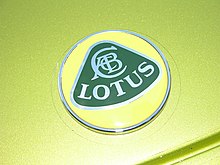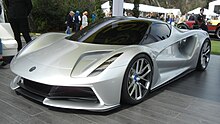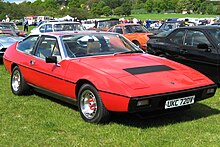โลตัส (รถยนต์)
หน้าตา
(เปลี่ยนทางจาก Lotus Cars)
 | |
| ประเภท | Joint venture |
|---|---|
| อุตสาหกรรม | ยานยนต์ |
| ก่อตั้ง | 1948 |
| ผู้ก่อตั้ง | โคลิน แชปแมน |
| สำนักงานใหญ่ | ฮีเทล, นอร์โฟล์ค, , อังกฤษ, สหราชอาณาจักร |
พื้นที่ให้บริการ | ทั่วโลก |
บุคลากรหลัก |
|
| ผลิตภัณฑ์ | รถยนต์, automotive parts |
| รายได้ | |
| เจ้าของ |
|
พนักงาน | 1,487 (2017)[3] |
| เว็บไซต์ | www |



รถโลตัส (อังกฤษ: Lotus Cars Limited) เป็นบริษัทผลิตรถยนต์จากประเทศอังกฤษ เน้นการผลิตรถยนต์นั่งสมรรถนะสูงและรถแข่ง มีรุ่นที่มีชื่อเสียงหลายรุ่น อาทิเช่น เอสพรี, เอลาน, ยูโรปา และอีลิส รวมถึงทีมฟอร์มูลาวันที่ประสบความสำเร็จ โรงงานผลิตรถโลตัสตั้งอยู่ที่ ฮีเทล (Hethel) ในนอร์โฟล์ค ซึ่งเดิมเคยเป็นฐานทัพทหารอากาศแห่งสหราชอาณาจักร ในช่วงสงครามโลกครั้งที่ 2 บริษัทเน้นการออกแบบรถสปอร์ตขนาดเล็กที่มีน้ำหนักน้อยและมีระบบแฮนด์ลิงที่ดี[4]
โลตัสเคยเปลี่ยนเจ้าของหลายครั้งในปี 1986 ก็ถูกขายให้กับเจเนรัลมอเตอร์ ต่อมาก็ถูกขายกับนายโรมานา อาร์ติโอลิ (Romano Artioli) ในปี 1996 ผู้ซึ่งเคยเป็นอดีตเจ้าของบูกัตติ แต่ภายหลังการล้มละลายของบริษัท ก็ถูกขายให้กับ DRB-HICOM บริษัทสัญชาติมาเลเซีย และเป็นบริษัทลูกของโปรตอนอีกทีหนึ่งด้วย
รุ่นปัจจุบัน
[แก้]


- โลตัส เอวิจา (Lotus Evija) รถสปอร์ตไฟฟ้าสุดเร็วที่สุดของโลกจากปี 2019 กับข้อมูลประวัติเล็กน้อยของรถสุดเจ๋งคันนี้ ที่คุณอาจยังไม่รู้ ความเร็วสูงระดับต้นของโลก กำลังขับเคลื่อนของล้อทั้ง 4 ข้างมีแรงดันไฟฟ้าสูง 1000+ ที่ถือได้ว่า เป็นรถไฟฟ้าคันแรกของโลก ที่มีกำลังขับเคลื่อนสูงพอ ๆ กับรถที่ใช้น้ำมัน Evija ถูกผลิตด้วยจำนวนจำกัดเพียงแค่ 120 คันเท่านั้น สำหรับคนที่สนใจ อยากทดสอบกระเป๋าตังค์ตัวเอง ว่าจะหนาพอที่จะซื้อ เจ้าหนูสุดซิ่งคันนี้ได้หรือไม่ Lotus Evija ราคา อยู่ที่ราว ๆ 6.7 ล้านปอนด์นิด ๆ หรือประมาณเงินเป็นบาทที่ 67 – 70 ล้านบาท โดยประมาณ
- โลตัส เอมิรา (Lotus Emira) รุ่นสุดท้ายที่ใช้เครื่องยนต์ มาต่อจาก อีลิส, เอ็กซิจ และ อีโวรา
- โลตัส อิเลตรา (Lotus Eletre) รถSUVไฟฟ้าคันแรกของค่าย
- โลตัส เอนวียา (Lotus Envya) รถเก๋งไฟฟ้าคันแรกของค่าย
รุ่นก่อนหน้า
[แก้]












- Lotus Mark I (1948): Austin 7–based sports car
- Lotus Mark II (1949–1950): Ford-powered trials car
- Lotus Mark III (1951): 750 cc formula car
- Lotus Mark IV (1952): Trials car
- Lotus Mark V (1952): 750 cc formula car, never built
- Lotus Mark VI (1953–1955): The first "production" racer, about 100 built
- Lotus Seven (1957–1972): A minimalist open sports car designed to manoeuvre a racing circuit.[5]
- Lotus Mark VIII (1954): sports racer, MG 1.5 L
- Lotus Mark IX (1955): sports racer, shorter and improved Eight
- Lotus Mark X (1955): sports racer for larger displacement, Bristol/BMW 2 L
- Lotus Eleven (1956–1957): small displacement sports racer (750 – 1500 cc)
- Lotus 12 (1956–1957): Formula Two and Formula One racecar
- Lotus 13: Designation not used
- Lotus 14 (1957–1963): Lotus Elite, the first production street car
- Lotus 15 (1958–1960): Sports racer, update of the Mk.X, Climax 1.5 – 2.5 L
- Lotus 16 (1958–1959): F1/F2 car, "Miniature Vanwall"
- Lotus 17 (1959): Lighter sports racer update of the 11 in response to Lola Mk.I
- Lotus 18 (1960–1961): First mid-engined Lotus single seater—Formula Junior/F2/F1
- Lotus 19 (1960–1962): Mid-engined larger displacement sports racer, "Monte Carlo"
- Lotus 20 (1961): Formula Junior
- Lotus 21 (1961): Formula One
- Lotus 22 (1962–1965): Formula Junior/F3
- Lotus 23 (1962–1966): Small displacement mid-engined sports racer
- Lotus 24 (1962): Formula One
- Lotus 25 (1962–1964): Formula One World Champion
- Lotus 26 (1962–1971): Lotus Elan, production street sports car
- Lotus 26R (1962–1966): Racing version of Elan
- Lotus 27 (1963): Formula Junior
- Lotus 28 (1963–1966): Lotus version of the Ford Cortina street/racer
- Lotus 29 (1963): Indy car, Ford all-aluminium OHV small block V8
- Lotus 30 (1964): Large displacement sports racer (Ford small block V8)
- Lotus 31 (1964–1966): Formula Three space frame racer
- Lotus 32 (1964–1965): Monocoque F2 and Tasman Cup racer
- Lotus 33 (1964–1965): Formula One World Champion
- Lotus 34 (1964): Indy car, DOHC Ford V8
- Lotus 35 (1965): F2/F3/FB
- Lotus 36 (1965–1968): Elan Fixed Head Coupe (Type 26 could be fitted with a removable hard top)
- Lotus 38 (1965): Indy winning mid-engined car
- Lotus 39 (1965–1966): Tasman Cup formula car
- Lotus 40 (1965): Sports racer, a development of the 30
- Lotus 41 (1965–1968): Formula Three, Formula Two, Formula B
- Lotus 42 (1967): Indy car, Ford V8
- Lotus 43 (1966): Formula One
- Lotus 44 (1967): Formula Two
- Lotus 45 (1966–1974): Convertible (Drop Head Coupe) Elan with permanent side window frames.
- Lotus 46 (1966–1968): Original Renault-engined Europa
- Lotus 47 (1966–1970): Racing version of Europa
- Lotus 48 (1967): Formula Two
- Lotus 49 (1967–1969): Formula One World Champion
- Lotus 50 (1967–1974): Lotus Elan +2, four-seat production car
- Lotus 51 (1967–1969): Formula Ford
- Lotus 52 (1968): Prototype Europa Twin Cam
- Lotus 53 (1968): Small displacement sports racer, never built
- Lotus 54 (1968–1970): Series 2 'Europa' production car.
- Lotus 55 (1968): F3
- Lotus 56 (1968–1969): Indy turbine wedge
- Lotus 56B (1971): F1 turbine wedge
- Lotus 57 (1968): F2 design study
- Lotus 58 (1968): F1 design study
- Lotus 59 (1969–1970): F2/F3/Formula Ford
- Lotus LX (1960): Lotus Elite built to win at Le Mans with a 2.0 L FPF engine.
- Lotus 60 (1970–1973): Lotus Seven S4, Greatly modified version of the Seven
- Lotus 61 (1969): Formula Ford, "the wedge"
- Lotus 62 (1969): prototype Europa racer
- Lotus 63 (1969): 4-wheel drive F1
- Lotus 64 (1969): 4-wheel drive Indy car, did not compete
- Lotus 65 (1969–1971): Federalized Europa S2
- Lotus 66: Can-Am design study[6]
- Lotus 67 (1970): Proposed Tasman Cup car, never built
- Lotus 68 (1969): F5000 prototype
- Lotus 69 (1970): F2/F3/Formula Ford
- Lotus 70 (1970): F5000/Formula A
- Lotus 71: Undisclosed design study
- Lotus 72 (1970–1972): Formula One World Champion
- Lotus 73 (1972–1973): F3
- Lotus 74 - Texaco Star (1973): F2
- Lotus 74 (1971–1975): Europa Twin Cam production car
- Lotus 75 (1974–1982): Elite II, Luxury 4-seat GT
- Lotus 76 (1974): F1, redundant designation
- Lotus 76 (1975–1982): Éclat S1, fastback version of Elite II, redundant designation
- Lotus 77 (1976): F1
- Lotus 78 (1977–1978): F1 ground effects car
- Lotus 79 (1975–1980) Lotus Esprit, street GT,[7] redundant designation
- Lotus 79 (1978–1979): Formula One World Champion, redundant designation
- Lotus 80 (1979): F1
- Lotus 81 (1979–1980): Sunbeam Talbot Lotus, redundant designation
- Lotus 81 (1980–1981): F1, redundant designation
- Lotus 82 (1982–1987): Turbo Esprit, street GT car
- Lotus 83 (1980): Elite series 2
- Lotus 84 (1980–1982): Éclat series 2
- Lotus 85 (1980–1987): Esprit series 3
- Lotus 86 (1980–1983): F1 dual chassis, never raced
- Lotus 87 (1980–1982): F1
- Lotus 88 (1981): F1 dual chassis car, banned
- Lotus 89 (1982–1992): Lotus Excel GT, re-engineered Éclat
- Lotus M90/X100: Toyota-based "new Elan", abandoned in favour of the Elan M100
- Lotus 91 (1982): F1
- Lotus 92 (1983): F1
- Lotus 93T (1983): F1 Turbo
- Lotus 94T (1983): F1 Turbo
- Lotus 95T (1984): F1 Turbo
- Lotus 96T (1984): Indy car project, abandoned
- Lotus 97T (1985–1986): F1 Turbo
- Lotus 98T (1986–1987): F1 Turbo
- Lotus 99T (1987): F1 Turbo, last Lotus F1 winner
- Lotus 100T (1988): F1 Turbo
- Lotus Elan (Type M100) (1989–1995): Front-drive convertible Elan.
- Lotus 101 (1989): F1
- Lotus 102 (1990–1991): F1
- Lotus 103 (1990): F1, not produced
- Lotus 104 (1990–1992): Lotus Carlton/Omega, tuned version of the Opel/Vauxhall saloon.
- Lotus 105 (1990): Racing X180R, IMSA Supercars Drivers Champ (Doc Bundy)
- Lotus 106 (1991): X180R, roadgoing homologation special
- Lotus 107 (1992–1994): F1
- Lotus 108 (1992): a track only bike ridden by Chris Boardman to win a gold medal at the 1992 Barcelona Olympics, also known as the "LotusSport Pursuit Bicycle".
- Lotus 109 (1994): F1, Last Lotus F1 car.
- Lotus 110 : Road and TT bike. Often mistaken for the Lotus 108 but completely different bikes.
- Lotus 111 (1996–Present): Lotus Elise
- Lotus 112: Partial F1 design, reached as far as the monocoque buck
- Lotus 113: Number not allocated
- Lotus 114 (1996): Lotus Esprit GT1 race car
- Lotus 115 (1997–1998): Lotus Elise GT1
- Lotus 116: Opel Speedster/Vauxhall VX220, a collaboration with Opel
- Lotus 117: Lotus Elise S2[ต้องการอ้างอิง]
- Lotus 118: Lotus M250, two-seat mid-range sports car concept unveiled in Autumn of 1999, project cancelled in 2001
- Lotus 119 (2002): Soapbox Derby car made of carbon and aluminium, disc brakes, no engine, for Goodwood Festival of Speed
- Lotus 120 (1998): Elise V6, code named M120, never produced
- Lotus 121 (2000–Present): Lotus Exige
- Lotus 121 (2006): Europa S[8]
- Lotus 122 (2007-2011): Lotus 2-Eleven, 0-door speedster
- Lotus 123 (2010–Present): Lotus Evora
- Lotus 124: Lotus Evora, race car
- Lotus T125 (2010): Lotus Exos[9]
- Lotus T127 (2010): Team Lotus F1 car, made for 2010 season
- Lotus T128 (Formula One car) (2011): Team Lotus F1 car, made for 2011 season
- Lotus T128 (Le Mans Prototype) (2013): race car built for 24 Hours of LeMans
- โลตัส อีลิส (Lotus Elise)
- โลตัส เอ็กซิจ (Lotus Exige S)
- โลตัส อีโวลา (Lotus Evora)
- Lotus 129 (2016–2022): Lotus 3-Eleven, 0-door speedster
- Lotus 130 (2021–ปัจจุบัน): Lotus Evija, all-electric hypercar
- Lotus 131 (2022–ปัจจุบัน): Lotus Emira, เปิดตัว 6 กรกฎาคม 2564
- Lotus 132 (2023–อนาคต): Electric Hyper SUV, teased 8 พฤศจิกายน 2564 by Lotus, เปิดตัว 29 มีนาคม 2565, becoming a new competitor in the rapidly expanding premium electric SUV segment.
- Lotus 133 (2024–อนาคต): Sedan, all-electric four-door super saloon
- Lotus 134 (2025–อนาคต): Mid-size SUV, all-electric
- Lotus 135 (2026–อนาคต): Sports car, all-electric supercar
อ้างอิง
[แก้]- ↑ Campbell, Peter (15 March 2019). "Lotus Cars plans major turnround after Geely cash boost". Financial Times. สืบค้นเมื่อ 31 May 2020.
- ↑ "GEELY & PROTON" (Press release). Proton. 23 June 2017. สืบค้นเมื่อ 23 June 2017.[ลิงก์เสีย]
- ↑ "Lotus Cars". สืบค้นเมื่อ 5 June 2018.
- ↑ "2010 Lotus Evora – Test drive and new car review – 2010 Lotus Evora". Cars.about.com. 16 June 2011. สืบค้นเมื่อ 18 December 2011.
- ↑ The rights to the Seven were sold in 1973 to Caterham Cars. Updated versions of this 1957 design are also produced by other speciality firms, including Westfield Sportscars and Donkervoort. Originally the number seven was applied to a Riley-powered Formula 2 car, but the vehicle was never completed in its original form, finally emerging instead as the Clairmonte Special, a two-seat sports car powered by a Lea-Francis engine.
- ↑ Chapman, Clive (September 2016). "The Lotus That Never Blossomed". Motor Sport. Vol. 92 no. 9. pp. 84–85.
- ↑ A mid-engined sports car, launched in the early 1970s. It was styled by Italian designer Giorgetto Giugiaro. The Esprit started with a light, 4-cylinder design, which went through several iterations of turbo-charging and electronic upgrades, before finally being replaced by a highly advanced V8. The last Lotus Esprit rolled off the production line on 20 February 2004, after 28 years in production. A total of 10,675 Esprits were built since production began in 1976.
- ↑ GT inspired two-seater claimed to offer a more upmarket sportscar experience, although it is based on the same chassis as the Elise and Exige, limiting accommodation and practicality. Power comes from a Lotus-tuned variant of the turbocharged four-cylinder engine which powers the VX220. The Europa has been criticised in the motoring press for being expensive and for lacking equipment and practicality compared to rivals like the Porsche Cayman.
- ↑ "Lotus 125 'Ultimate Track Car' to Debut at Pebble Beach Alongside Elise SC RGB Edition | AutoGuide.com News". Autoguide.com. 5 August 2010. สืบค้นเมื่อ 30 September 2010.
